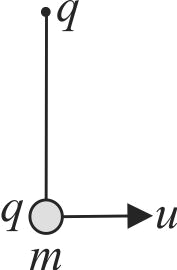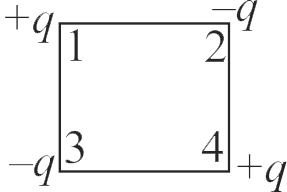359471
The bob of a pendulum has mass \(m = 1\,kg\) and charge \(q = 40\mu C.\) Length of pendulum is \(l = 0.9m.\) The point of suspension also has the same charge \(40\mu C.\) What is the minimum speed that should be imparted to the bob so that it can complete vertical circle?
359473 A ball of mass \(1\,g\) and charge \({10^{ - 8}}\,C\) starts from a point \(A\), where potential is \(600\,V\) to the point \(B\), where potential is zero. The velocity of the ball at the point \(B\), is \(20\,cm{s^{ - 1}}\). The velocity of the ball at the point \(A\) will be
359471
The bob of a pendulum has mass \(m = 1\,kg\) and charge \(q = 40\mu C.\) Length of pendulum is \(l = 0.9m.\) The point of suspension also has the same charge \(40\mu C.\) What is the minimum speed that should be imparted to the bob so that it can complete vertical circle?
359473 A ball of mass \(1\,g\) and charge \({10^{ - 8}}\,C\) starts from a point \(A\), where potential is \(600\,V\) to the point \(B\), where potential is zero. The velocity of the ball at the point \(B\), is \(20\,cm{s^{ - 1}}\). The velocity of the ball at the point \(A\) will be
359471
The bob of a pendulum has mass \(m = 1\,kg\) and charge \(q = 40\mu C.\) Length of pendulum is \(l = 0.9m.\) The point of suspension also has the same charge \(40\mu C.\) What is the minimum speed that should be imparted to the bob so that it can complete vertical circle?
359473 A ball of mass \(1\,g\) and charge \({10^{ - 8}}\,C\) starts from a point \(A\), where potential is \(600\,V\) to the point \(B\), where potential is zero. The velocity of the ball at the point \(B\), is \(20\,cm{s^{ - 1}}\). The velocity of the ball at the point \(A\) will be
359471
The bob of a pendulum has mass \(m = 1\,kg\) and charge \(q = 40\mu C.\) Length of pendulum is \(l = 0.9m.\) The point of suspension also has the same charge \(40\mu C.\) What is the minimum speed that should be imparted to the bob so that it can complete vertical circle?
359473 A ball of mass \(1\,g\) and charge \({10^{ - 8}}\,C\) starts from a point \(A\), where potential is \(600\,V\) to the point \(B\), where potential is zero. The velocity of the ball at the point \(B\), is \(20\,cm{s^{ - 1}}\). The velocity of the ball at the point \(A\) will be

